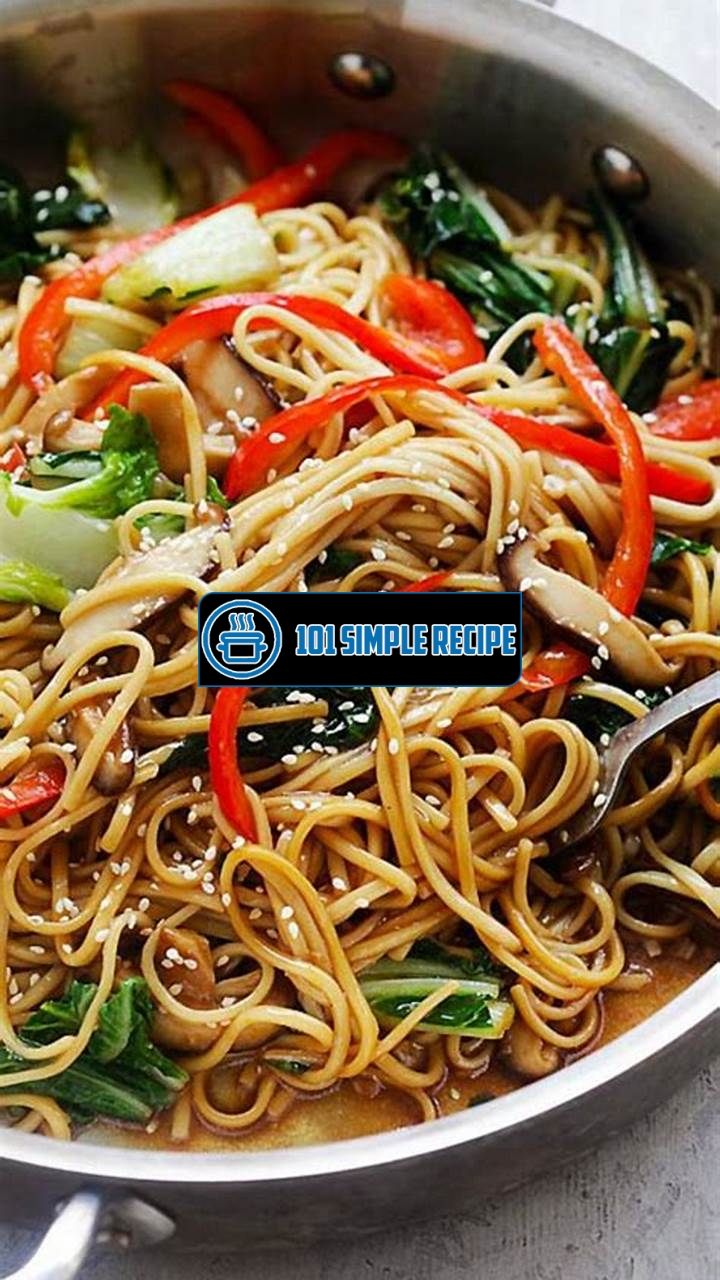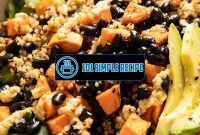Are Lo Mein Noodles Healthy? An Honest Analysis

When it comes to ordering Chinese takeout or cooking up a quick and delicious meal at home, few options are more tempting than a piping hot plate of lo mein noodles. But are they really as healthy as they seem? In this honest analysis, we’ll delve into the nutritional profile of lo mein noodles and uncover the truth behind their reputation. Brace yourself for some surprising facts and get ready to make informed choices for your next Chinese food indulgence!
The Nutritional Value of Lo Mein Noodles
Lo mein noodles are a popular dish in Chinese cuisine that can be found in restaurants around the world. These noodles are made from wheat flour and typically stir-fried with various vegetables and protein sources such as chicken, beef, or shrimp. While some may question the healthiness of lo mein noodles due to their association with fried dishes, they can actually offer several nutritional benefits when prepared and consumed in a balanced manner.
The Composition of Lo Mein Noodles
Lo mein noodles are primarily made from wheat flour, water, and sometimes eggs. These ingredients combine to create a chewy and slightly tender texture that is beloved by many. Unlike other types of noodles, such as rice noodles or cellophane noodles, lo mein noodles have a higher gluten content due to the use of wheat flour. This gives them a slightly firmer bite and allows them to hold up well when cooked with other ingredients or in soups.
Key Nutrients in Lo Mein Noodles
In addition to being a good source of carbohydrates, lo mein noodles provide essential nutrients that are necessary for maintaining overall health. These include:
- Protein: Lo mein noodles contain a moderate amount of protein, which is essential for muscle growth and repair. Protein also helps to keep you feeling full and satisfied after a meal.
- Fiber: While not as high in fiber as whole wheat noodles, lo mein noodles still provide a decent amount of this important nutrient. Fiber aids in digestion, promotes bowel regularity, and can help prevent constipation.
- Vitamins and minerals: Lo mein noodles contain small amounts of various vitamins and minerals, including iron, calcium, and B vitamins. These nutrients play a crucial role in many bodily functions, such as supporting the immune system and maintaining bone health.
Health Benefits of Lo Mein Noodles
When prepared in a healthy way, lo mein noodles can be part of a well-rounded and nutritious diet. Here are some of the potential health benefits they offer:
- Energy boost: As a source of carbohydrates, lo mein noodles provide energy that can fuel your daily activities. They can be especially beneficial for those who engage in regular physical activity or have high energy needs.
- Weight management: Lo mein noodles, when consumed in moderation, can be incorporated into a balanced diet for weight management. Their complex carbohydrates and fiber content can help keep you feeling fuller for longer, reducing the risk of overeating.
- Improved digestion: The fiber content in lo mein noodles can help promote healthy digestion and prevent gastrointestinal issues, such as bloating and constipation.
- Brain function: Carbohydrates from lo mein noodles act as the primary fuel source for your brain. Consuming them as part of a balanced meal can help support optimal brain function and cognitive performance.
It’s important to note that the healthiness of lo mein noodles depends on how they are prepared. Opting for stir-fried or sautéed versions with plenty of vegetables and lean protein can boost the nutritional value of the dish. Conversely, heavily fried or greasy lo mein noodles should be consumed in moderation due to their higher fat and calorie content.
In conclusion, lo mein noodles can be a healthy and nutritious addition to your diet when prepared and consumed wisely. Incorporating them into stir-fried dishes with a variety of colorful vegetables can provide essential nutrients and contribute to a well-balanced meal. Just remember to practice portion control and choose healthier cooking methods to maximize their nutritional benefits.
Choosing Healthy Lo Mein Noodles
When it comes to enjoying a delicious plate of lo mein noodles, it’s important to choose a variety that aligns with your health goals. With so many options available, it can be overwhelming to determine which ones are the best for you. However, by following these tips and tricks, you can make an informed decision and enjoy your lo mein guilt-free.
Reading Food Labels
Reading food labels is an essential step in selecting healthy lo mein noodles. By carefully examining the nutritional information provided, you can assess the quality of the noodles and choose an option that fits your dietary needs. Pay attention to the following key factors:
- Calories: Look for lo mein noodles with a moderate calorie content. Opting for a lower-calorie option can help you maintain a healthy weight and avoid excessive calorie intake.
- Fat: Keep an eye out for the amount of fat in the noodles. Choosing a variety with lower fat content can be beneficial for heart health and weight management.
- Sodium: Excessive sodium intake can contribute to high blood pressure. Select noodles that are lower in sodium to maintain a healthy blood pressure level.
- Carbohydrates: Lo mein noodles are primarily made of carbohydrates. However, it’s important to choose options that provide complex carbohydrates, such as whole wheat noodles, for sustained energy release.
- Protein: Protein is an essential nutrient that promotes satiety and muscle repair. Look for lo mein noodles that offer a decent amount of protein for a more balanced meal.
- Sugar: Avoid noodles with added sugars, as they can contribute to weight gain and other health issues. Choose options with little to no added sugars for a healthier choice.
By carefully reading food labels, you can make an educated decision about which lo mein noodles are the best fit for your dietary needs and health goals.
Whole Wheat vs. Regular Lo Mein Noodles
When comparing whole wheat and regular lo mein noodles, it’s important to consider the nutritional differences between the two.
Whole wheat lo mein noodles:
- Made from whole wheat flour, providing more fiber and nutrients compared to regular noodles.
- Contain complex carbohydrates, which contribute to sustained energy release.
- Typically have a nuttier flavor and denser texture.
Regular lo mein noodles:
- Made from refined flour, resulting in a smoother texture.
- ❌ Lack the beneficial fiber and nutrients found in whole wheat noodles.
- May lead to a quicker rise in blood sugar levels due to their higher glycemic index.
While regular lo mein noodles can still be enjoyed in moderation, opting for whole wheat noodles provides added nutritional benefits. They are a great source of fiber, vitamins, and minerals. Additionally, their complex carbohydrates can help you feel full for longer periods, supporting your overall health goals.
Gluten-Free Options
For individuals with gluten sensitivities or dietary restrictions, finding gluten-free lo mein noodles is essential. Fortunately, there are several alternative options available that can satisfy your cravings while keeping your health in check.
Here are some gluten-free alternatives to traditional lo mein noodles:
- ✅ Rice Noodles: Made from rice flour, these noodles have a mild flavor and a slightly chewy texture.
- ✅ Bean Thread Noodles: Also known as cellophane or glass noodles, these transparent noodles are made from mung bean starch and are gluten-free.
- ✅ Zucchini Noodles: For a low-carb option, spiralized zucchini can be used as a substitute for lo mein noodles. They provide a light and refreshing twist to the dish.
By exploring gluten-free alternatives, individuals with gluten sensitivities can still enjoy the delicious flavors of lo mein without worrying about any adverse reactions.
In conclusion, when selecting lo mein noodles, educate yourself by reading food labels and considering factors such as calories, fat, sodium, carbohydrates, protein, and sugar content. Choosing whole wheat noodles over regular ones can provide added nutrition and fiber, while gluten-free options cater to individuals with special dietary needs. Enjoy your lo mein while staying true to your health goals!
Balancing Lo Mein Noodles in a Healthy Diet
When it comes to incorporating lo mein noodles into a healthy diet, it’s important to strike a balance. While these noodles can be a delicious addition to your meals, they should be consumed in moderation and paired with nutrient-rich ingredients. By following a few simple guidelines, you can enjoy lo mein noodles as part of a well-rounded and nutritious eating plan.
Serving Size and Portion Control
One of the key aspects of maintaining a healthy diet is practicing portion control. This applies to lo mein noodles as well. While it may be tempting to load your plate with a heaping portion of noodles, it’s important to remember that moderation is key. A typical serving size of lo mein noodles is about 1 cup, which provides you with a satisfying portion without going overboard.
Tip: Use a measuring cup to ensure you are serving yourself an appropriate portion of lo mein noodles.
Pairing Lo Mein Noodles with Protein and Veggies
In order to make your lo mein noodles a well-rounded meal, it’s crucial to pair them with protein and vegetables. This not only adds nutritional value to your dish but also helps to create a more satisfying and balanced meal.
Protein: Choose lean sources of protein such as chicken, shrimp, tofu, or edamame to accompany your lo mein noodles. These options provide essential amino acids and help to keep you feeling full and satisfied.
Veggies: Load up your plate with a variety of colorful vegetables like bell peppers, broccoli, carrots, and snow peas. These veggies not only add a burst of flavor but also contribute important vitamins, minerals, and fiber to your meal.
Alternatives to Traditional Lo Mein Noodles
If you’re looking to switch things up or if you have dietary restrictions, there are alternatives to traditional lo mein noodles that can still offer a delicious and nutritious experience.
Vegetable Noodles: Swap out the regular lo mein noodles for vegetable noodles made from zucchini, sweet potatoes, or carrots. These options are lower in calories and carbohydrates while providing an extra dose of vitamins and fiber.
Whole Wheat Noodles: Opt for whole wheat or whole grain lo mein noodles instead of refined white noodles. Whole wheat noodles are higher in fiber, which aids in digestion and helps to keep you feeling fuller for longer.
Brown Rice Noodles: Another alternative to consider is using brown rice noodles. These noodles offer a nutty flavor and are gluten-free, making them a suitable choice for individuals with gluten sensitivities or dietary restrictions.
This is just a small taste of the possibilities for incorporating lo mein noodles into a healthy and balanced eating plan. With the right portion sizes, paired with protein and veggies, or by exploring alternative noodle options, you can enjoy this flavorful dish without compromising your health goals.
Healthier Cooking Methods for Lo Mein Noodles
When it comes to enjoying a plate of delicious lo mein noodles, you may wonder if they can be a healthy choice. Fortunately, there are cooking techniques that can help reduce the calorie and fat content of this popular dish, allowing you to savor its flavors without guilt. Let’s explore these methods in detail:
Stir-Frying vs. Deep-Frying
One of the key factors in making lo mein noodles healthier is the cooking method. Stir-frying is a preferable option as it requires less oil compared to deep-frying. Stir-frying involves quickly cooking the noodles and vegetables in a hot pan or wok with a small amount of oil. This method helps retain the nutrients and natural flavors of the ingredients, resulting in a lighter dish. On the other hand, deep-frying involves immersing the noodles in a large volume of oil, which significantly increases the calorie and fat content. It’s best to avoid deep-fried lo mein noodles if you’re aiming for a healthier meal.
Using Lean Proteins and Healthy Oils
Another way to make your lo mein noodles healthier is by using lean proteins and healthy oils. Opt for lean protein sources such as shrimp, chicken breast, or tofu instead of fatty meats like pork or beef. These lean options provide essential nutrients without adding excessive calories. Additionally, choose healthy oils like olive oil or sesame oil for stir-frying the noodles. These oils have a higher proportion of unsaturated fats, which are considered more beneficial for heart health. Remember to use them in moderation to control the overall fat content of your dish.
Reducing Sodium Content
Reducing the sodium content in your lo mein noodles is another important aspect of making them healthier. High sodium intake can contribute to various health issues, including high blood pressure. To lower the sodium content, you can use reduced-sodium soy sauce or even opt for low-sodium or no-salt-added versions. Additionally, you can increase the amount of vegetables in your dish to add more flavor and texture without relying heavily on salt. Experimenting with herbs and spices can also enhance the taste without the need for excessive sodium.
By adopting these healthier cooking methods, you can still enjoy the delightful flavors of lo mein noodles while maintaining a well-balanced diet. Remember, moderation is key, and it’s essential to choose high-quality ingredients to ensure your dish packs a punch in terms of both taste and nutrition.
Delicious and Nutritious Lo Mein Noodle Recipe Ideas
Get inspired with flavorful and healthy lo mein noodle recipes that you can easily recreate at home. Whether you’re a vegetarian, a fan of chicken and broccoli, or enjoy the taste of shrimp and snow peas, there’s a lo mein recipe for everyone to enjoy.
Vegetable Lo Mein with Tofu
If you’re looking for a nutrient-packed option, vegetable lo mein with tofu is a fantastic choice. Tofu provides a good source of plant-based protein, while the assortment of vegetables ensures you’re getting a variety of vitamins and minerals. Some popular veggies to include are carrots, bell peppers, mushrooms, and bean sprouts. These ingredients not only add flavor and texture to the dish but also provide a range of important nutrients to support your overall health.
Incorporate colorful veggies to make your dish visually appealing and add an extra dose of vitamins and antioxidants.
Chicken and Broccoli Lo Mein
If you prefer a heartier option, chicken and broccoli lo mein is a classic choice. This recipe combines tender chicken breast, nutrient-rich broccoli, and savory lo mein noodles. Chicken is a great source of lean protein, which is essential for muscle repair and growth. Broccoli, on the other hand, is packed with fiber, vitamins A and C, and various antioxidants. Together, they make a flavorful and nutritious combination.
Opt for skinless chicken breasts to reduce the intake of saturated fats and cholesterol.
Shrimp and Snow Pea Lo Mein
For seafood lovers, shrimp and snow pea lo mein is a must-try recipe. Shrimp is not only a low-calorie protein source but also rich in omega-3 fatty acids, which promote heart health. Snow peas are a crunchy and refreshing addition that provides dietary fiber and vitamins A and C. The combination of shrimp, snow peas, and lo mein noodles creates a delicious dish that satisfies both your taste buds and nutritional needs.
Look for sustainably sourced shrimp to protect the environment and support responsible fishing practices.
No matter which recipe you choose, lo mein noodles can be a healthy addition to your meal. They are made from wheat flour, which provides energy and dietary fiber. However, it’s important to control your portion size and be mindful of the sauce you use, as some can be high in sodium and unhealthy fats.
Opt for whole wheat lo mein noodles for a higher fiber content and a lower glycemic index, helping you feel fuller for longer periods.
Don’t shy away from adding herbs and spices to your lo mein dishes, such as ginger, garlic, and cilantro. They not only enhance flavor but also offer potential health benefits such as anti-inflammatory and immune-boosting properties.
By incorporating these lo mein noodle recipes into your meal rotation, you can enjoy a delicious and nutritious dish that suits your dietary preferences and promotes a healthy lifestyle. Experiment with different combinations of protein, vegetables, and sauces to create your own signature lo mein masterpiece!
Thank you for taking the time to read our article on “lo mein noodles healthy”. We hope you found it informative and helpful in your quest for healthier Chinese cuisine options. Don’t forget to visit our website again for more articles on delicious and nutritious recipes. Keep exploring and enjoy your culinary adventures!
Frequently Asked Questions
Here are some frequently asked questions about lo mein noodles:
| No. | Questions | Answers |
|---|---|---|
| 1. | Are lo mein noodles healthy? | Yes, lo mein noodles can be a healthy choice when prepared with fresh ingredients and in moderation. It’s important to control portion sizes and choose lean protein and plenty of vegetables to make it a balanced meal. |
| 2. | Is lo mein gluten-free? | No, traditional lo mein noodles are made from wheat flour and are not gluten-free. However, there are gluten-free alternatives available, such as rice noodles or zucchini noodles, that can be used to make a gluten-free version of lo mein. |
| 3. | How do you make lo mein noodles healthier? | To make lo mein noodles healthier, you can use whole wheat noodles instead of refined white noodles, load up on vegetables and lean protein, and minimize the use of added fats and sauces. Opting for homemade sauces with reduced sodium and sugar content is also a good idea. |
| 4. | Can I make lo mein noodles vegan? | Absolutely! Lo mein noodles can be made vegan by using vegetable-based protein options like tofu or tempeh, and by excluding meat or animal-derived ingredients from the sauce. You can also use vegetable broth and tamari instead of fish sauce for added flavor. |
| 5. | What are some healthy toppings for lo mein? | Some healthy toppings for lo mein include sliced scallions, crushed peanuts or almonds, bean sprouts, grated carrots, and chopped cilantro. These toppings add texture, flavor, and additional nutrients to your dish. |
| 6. | Can lo mein noodles be reheated? | Yes, you can reheat lo mein noodles by either stir-frying them in a pan with a little oil or reheating them in the microwave. Just make sure to store them properly in the refrigerator in an airtight container to maintain their texture and taste. |
Prepare a Healthy Lo Mein Noodles Recipe Today!
Now that you have all the information you need about making lo mein noodles healthy, why not try preparing a delicious and nutritious lo mein noodles recipe? With the right ingredients and cooking techniques, you can enjoy a flavorful and guilt-free Chinese dish right at home. Don’t hesitate to experiment with different vegetables and protein sources to customize your lo mein noodles according to your preferences. Stay adventurous in the kitchen and enjoy the wonders of healthy eating!
Jump to Recipe
Healthy Lo Mein Noodles

A delicious and healthier version of traditional lo mein noodles packed with fresh ingredients and balanced flavors.
- 8 ounces whole wheat lo mein noodles
- 2 tablespoons vegetable oil
- 2 cloves garlic (minced)
- 1- inch piece ginger (grated)
- 1 red bell pepper (thinly sliced)
- 1 cup sliced shiitake mushrooms
- 2 cups broccoli florets
- 2 carrots (julienned)
- 1 cup snow peas
- 2 tablespoons reduced-sodium soy sauce
- 1 tablespoon oyster sauce
- 1 tablespoon rice vinegar
- 1/2 teaspoon sesame oil
- 1/4 cup chopped scallions (for garnish)
- 1 tablespoon sesame seeds (for garnish)
- Bring a large pot of water to a boil. Cook the lo mein noodles according to the package instructions. Drain and set aside.
- In a small bowl, whisk together the soy sauce, oyster sauce, rice vinegar, and sesame oil. Set aside.
- Heat the vegetable oil in a large pan or wok over medium-high heat. Add the garlic and ginger and cook for 1 minute, until fragrant. Add the bell pepper, shiitake mushrooms, broccoli, carrots, and snow peas. Stir-fry for 5-6 minutes, until the vegetables are crisp-tender.
- Add the cooked lo mein noodles to the pan with the vegetables. Pour the sauce over the noodles and toss to coat everything evenly. Cook for an additional 2-3 minutes, until heated through.
- Transfer the lo mein noodles to serving plates. Sprinkle with chopped scallions and sesame seeds for garnish. Enjoy your healthy lo mein noodles!






